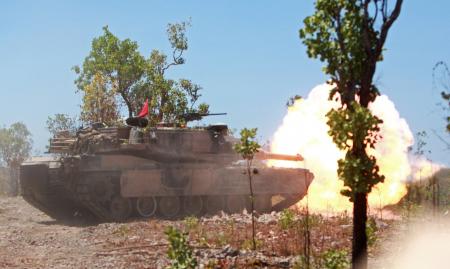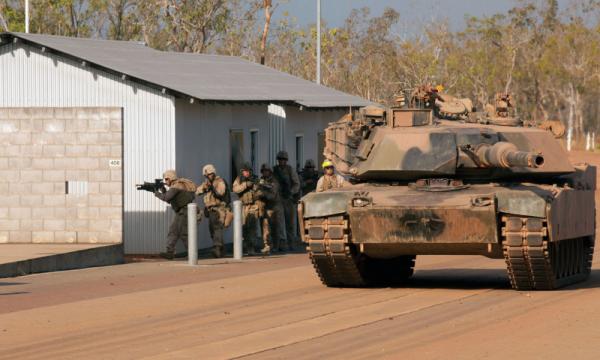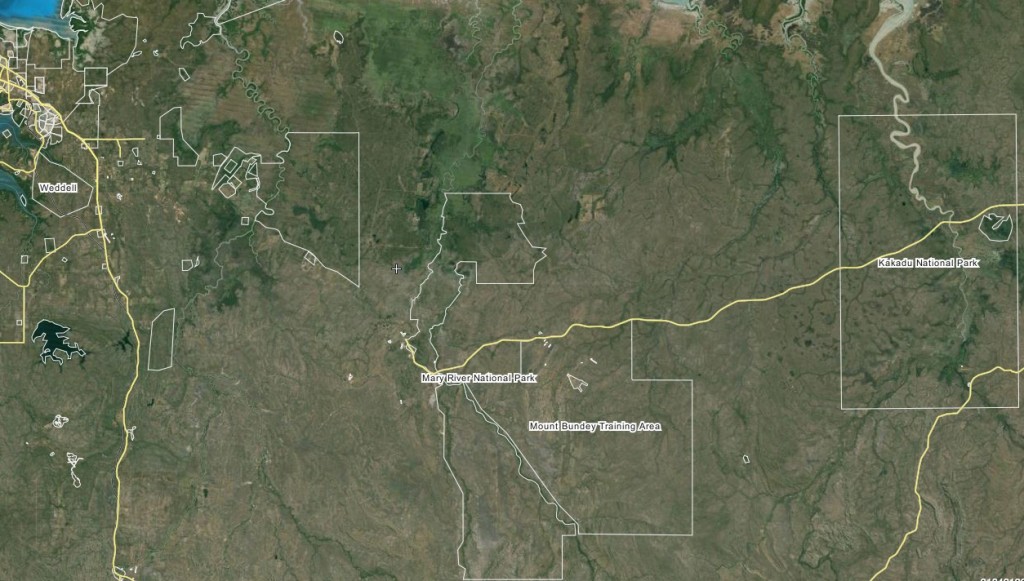Introduction
The Mount Bundey Training Area (MBTA) is a 117300 ha. site,75km south-east of Humpty Doo, south of the Arnhem Highway, between the Mary River and Kakadu National Park. Previously a cattle station, the property was acquired as a training area in 1988.
United States and Singaporean forces both conduct joint tank exercises with Australian forces at the MBTA, including the use of an Urban Operations Training Facility constructed in 2005.
Mount Bundey Training Area has been heavily used by the US Marine Air Ground Task Force since its first deployment in 2012.
In mid-2017 the ADF held Exercise Southern Jackaroo at Mount Bundey with elements of the 1st Brigade – Australian Army, US Marine Rotation Force – Darwin (MNRF-D) and the Japanese Ground Self Defence Force (JGSDF). [Video]
Location
12°59’56″S, 131°47’49″E
Mt. Bundey Training Area, Wikimapia
Government documents
Australia
Mount Bundey Military Training Area, Arnhem Hwy, Humpty Doo, NT, Australia, Australian Heritage Database
Talisman Sabre 2013, Final Public Environment Report, Aurecon Australia for Department of Defence, december 2012
The Mount Bundey Training Area is bounded by the Arnhem Highway to the north, Mary River and the proposed Mary River National Park to the west, and Kakadu National Park to the east through to the south. The Mount Bundey Training Area is included on the Commonwealth Heritage List for its variety of fauna habitats of waterways, floodplains and rainforest pockets supporting a range of species. Mount Bundey Training Area is designed to support training in fieldmanoeuvres and field live firing. It has field firing areas, high explosive impact areas, training sectors and infrastructure to support management and operational use. Infrastructure at Mount Bundey Training Area is limited, and includes a road network, maintenance areas, a Range Control facility, a 200 person campsite and a number of support facilities including built ranges.
External access to the Mount Bundey Training Area is provided via the Arnhem Highway, which has direct connection to Stuart Highway providing direct transport link to Darwin. The Mount Bundey Training Area has an internal road network of unsealed gravel roads, appropriate for all weather use – although movement is generally restricted during the wet season to prevent damage to roads and tracks and damage to vehicles.
S13 Planned Activities at Mount Bundey Training Area Sphere TS13 Planned Activities
Air
− Helicopter flying including low-level (<1,000ft), take off / landing and troop insertions
− Live firing of weapons (gunnery, bombing, missiles and rockets)
− Emergency dumping of fuels and jettisoning of stores (in emergency situations only)
− Aircraft deployed countermeasures
− Use of aircraft radar
− Use of lasers
Land
− Deployment of personnel/equipment by land
− Live firing of weapons (armoured vehicles, artillery, mortar, infantry)
− Establishment and maintenance of target areas, gun positions
− Logistics support (facilities, camp sites, infrastructure etc.)
− Construction and maintenance (roads, bridges, route clearance)
− Detection and removal of unexploded ordnance (UXO)
− Tactical manoeuvres and battle runs
− Storage and movement of ammunition to the training area
− Use of lasers
− Deployment of smoke canisters
− Use of flares and pyrotechnics and battle noise simulation
− Explosive obstacle clearing
− Defensive training against nuclear, biological and chemical warfare (does not include use of these weapons)
− Putrescible / non-putrescible waste, sewerage and grew water collection, treatment and disposal
− Establishment and operation of fuel farms, field workshops, field medical facilities, field power generation and distribution, fuel distribution
Northern Territory, Defence Environmental Partnerships, Department of Defence, 2011
In 2011-12, the Territory will host six Defence exercises:
- Exercise MATILDA – a combined non-reciprocal sub-unit exercise conducted in the Mount Bundy Training Area in which the Singapore Armed Forces and the Australian Army 1st Brigade conduct an exercise to enhance tactical skills and interoperability between both forces.
- Exercise GOLD EAGLE – a bilateral exercise conducted between elements of the Australian Army 1st Brigade and USMC to enhance tactical skills and interoperability between both forces. The exercise is conducted in the Mount Bundy Training Area.
- Exercise PREDATORS WALK – an Australian Army 1st Brigade-led activity involving combat team level, dry and live firing manoeuvres in the Mount Bundy Training Area.
Construction and operation of an urban operations training facility at the Mt Bundey Training Area, Northern Territory : final public environment report prepared for Department of Defence by HLA-Envirosciences Pty Limited. Canberra: Dept. of Defence, 2005.
Mount Bundey Military Training Area, Arnhem Hwy, Humpty Doo, NT, Australian Heritage Database
Vegetation and Soil Mapping: Mt Bundey Training Area, Brian Tunstall, Tony Orr, and Alan Marks, CSIRO Australia, Technical Report 8/98, 1998
The MBTA was primarily acquired for training by the 2nd Cavalry Regiment and NORFORCE, but was to include other elements providing support, including Armour. The usage envisaged was:
- 2nd Cavalry Regiment (approximately 19 weeks per year)
- NORFORCE (approximately 12 weeks per year)
- battalion group (approximately 6 weeks per year)
- elements of brigade-level training every three years
The eastern part of the MBTA forms the upper reaches of the Wildman River catchment, which is registered on the National Estate because of extensive wetlands. The MBTA is remote from the wetlands that form the basis for listing, but represents a significant 26% of the catchment. The associated requirement for environmentally sustainable use is reinforced by the eastern boundary of the MBTA abutting Kakadu National Park, and the western areas forming part of the Mary River floodplain.
The climate broadly divides into the wet and dry periods of November to March, and April to October, respectively. Solar radiation and ambient temperatures are generally high. Maximum daily temperatures average around 37oC in October/November and around 32oC May through July. The annual rainfall averages around 1330 mm. Rainfall is highly seasonal with over 90% falling in the wet season of November to March.
Army Presence in the North, Department of Defence Performance Audit, Audit Report No. 27 1996-97, Tabled 5 March 1997
4.12 Army noted in 1991, 1994 and again in 1996 that Mount Bundey was inadequate as a manoeuvre training area for 1st Brigade. Mount Bundey was purchased in 1989, and the original user-requirement and environmental impact statement were based on the needs of the North West Mobile Force (NORFORCE) and the armoured reconnaissance regiment. The need to revise these documents to accommodate 1st Brigade needs was noted in 1996. Such a revision had not been programmed and was not included in APIN bids for 1996-97.
4.13 Mount Bundey is very limited in its capacity to handle sub-unit manoeuvre training, principally due to the effects of armoured vehicles on the environment and infrastructure. The armoured and armoured-reconnaissance regiments are also unable to conduct key aspects of their live-fire training due to limited range facilities.
4.14 Army recognised these limitations in its Northern Australia Training Area Study of 1994. As a result of this study, Army is seeking government approval to develop Bradshaw Field Training Area at a cost of about $54 million.
4.15 A proposal to transfer half of the Armoured Fighting Vehicle Field Firing Target System (AFV FFTS) from the armoured regiment’s former training area at Puckapunyal in Victoria was also initiated in June 1995. The aim was to install the system at Mount Bundey by June 1996. Army has not yet funded this system for Mount Bundey, and the armoured regiment must return to Puckapunyal to use the system there. Development of a moving target range at Mount Bundey, along with wet weather access, would be of important training benefit to APIN units but would nevertheless not meet all the manoeuvre training needs of the armoured regiment.
4.16 As a result, the armoured regiment has already had to transport a squadron of tanks to its former training area at Puckapunyal in order to carry out live fire and manoeuvre training. The cost of this relocation is unavailable. The arrangement is not entirely satisfactory since the Puckapunyal training area is different from northern Australian terrain and conditions.
Other possible limitations on training areas
4.18 The development of Bradshaw Field Training Area, planned for completion by 1999, should provide sufficient capacity for all 1st Brigade units. However, it has been foreshadowed by a Ministerial announcement, following Australian-US ministerial discussions in July 1996, that training areas in northern Australia are to be used by other Army units or units from foreign defence forces. As a result, it is unclear whether 1st Brigade units will have sufficient access to achieve their training objectives within the limited dry-season: this is discussed more fully at paragraph 4.21.
4.19 A further issue specific to training areas is that Army has not yet programmed the operating finance which will be required to support the new Bradshaw Field Training Area. Defence’s Force Structure Policy and Programming Committee has however noted Army’s intention to bid for supplementatry funding. Operating costs for Bradshaw Field Training Area are estimated by Army to be about $5.5 million per year. This figure is likely to change once more accurate information on the costs of environmental maintenance becomes available.
Northern wet season effects on training
4.20 The distance to, capacity of, and environmental fragility of training areas in the north limit the training opportunities available to armoured units, particularly the armoured regiment. Mechanised training (ie with Leopard tanks, M113 armoured personnel carriers and ASLAV Armoured Fighting Vehicles) is usually permissible in the north of Australia only within the dry season from early June to early October 6. During the remainder of the year the environmental damage from tracked and wheeled armoured vehicles on the ground is usually unsustainable north of Tennant Creek. Bradshaw Field Training Area and Mount Bundey training areas are both so affected.
4.21 Consequently, the 1st Brigade training cycle must be compressed into about half the time that was available in southern Australia. The ANAO considers that both the availability and capacity of Mount Bundey training area present a risk to satisfactory achievement of individual, crew, sub-unit and unit training objectives and therefore to operational readiness.
United States
Cpl. Reba James, Exercise Predator Walk kicks off as U.S. Marines depart Robertson Barracks, DVIDS 21 May 2015
“We are moving personnel, tactical vehicles and equipment to the training area as part of Predator Walk today,” said 1st Lt. William Roundtree, the 3rd platoon commander with Company B, 1st Battalion, 4th Marines, MRF-D and a native of Tuscaloosa, Alabama. “We will be integrated with the Australian Army as an entire battalion, along with the ground combat element and [aviation] combat element.”
Marine Corps capabilities for the training evolution will include the ground combat element, aviation combat element, logistics combat element and the command element. The consolidated task force includes engineers, artillery, CH-53E Super Stallion helicopters and all weapons organic to an infantry battalion.
Exercise Gold Eagle smooth ride for Aussie, Marine tanks, DVIDS, 17 September 2013
The tropical terrain of the Top End created quite a few obstacles for Marines with Alpha Company, 1st Tank Battalion, 1st Marine Division, to overcome during a live-fire exercise as part of the second half of Exercise Gold Eagle here, Sept. 14. Though the environment bared no resemblance to the desert terrain the Marines are used to facing, it allowed them to refine their tank skills with the help of the Australian soldiers from 1st Armoured Regiment, Royal Australian Armoured Corps, who are accustomed to such conditions.
Practicing maneuvers in a new environment is just one of the reasons why the two militaries are participating in the exercise. “Exercise Gold Eagle is a bilateral exchange. The Australians came over in June to conduct the US-leg, and now we’re on the backend with the reciprocal piece here in Australia,” said Capt. Nathan Gulosh, commanding officer, Alpha Co., 1st Tank Bn. “It’s an opportunity for our armored communities to share each other’s practices and just operate in a different environment.”
The course-of-fire began with the tanks destroying “enemy” dismounts and reconnaissance vehicles. After successfully removing that enemy threat, the tanks moved to a more open area where they eliminated combat security outpost positions. The tanks then traveled to an elevated piece of land where they denied enemy influence.
The combination of heavy foliage and deep ditches from dried creeks proved challenging for the Marines.
“This is a great chance for us to see and mentally take ourselves out of the conditions of an Operation Enduring Freedom fight,” said Gulosh. “We’re used to being able to see three to four clicks out. Here, because of the terrain, we can only see about 50 meters in front of us. We needed to change the way we thought about engaging a target. It’s good to get out here and see how these guys tank.”

Marines with Alpha Company, 1st Tank Battalion, engage a target from an M1A1 Abrams Main Battle Tank during Exercise Gold Eagle 2013, here, Sept. 14. ,
Source: Exercise Gold Eagle smooth ride for Aussie, Marine tanks, DVIDS, 17 September 2013
http://www.dvidshub.net/image/1020407/exercise-gold-eagle-smooth-ride-aussie-marine-tanks
MRF-D Marines and Australian soldiers train for two weeks at Mount Bundey, DVIDS, 14 June 2013
Marines with Weapons Platoon, Lima Company, 3rd Battalion, 3rd Marine Regiment, Marine Rotational Force – Darwin, and Australian soldiers with Bravo Company, 5th Battalion, Royal Australian Regiment, relied on the support of each other to complete various training exercises, here, from June 3 – 14. The Marines and their Australian counterparts traveled to every training exercise by foot, covering approximately 65 kilometers of land, while carrying approximately 90 pounds of gear on their backs.
Throughout their time at the training area, both units combined their abilities in completing urban operation exercises. However, the physical aspects of the missions were not the hardest part for the Marines and Australian soldiers.
Australian Army, US Marines combine arms during urban operations, Cpl. Jacob D. Barber, Stars and Stripes Okinawa, 22 September 2012
Marines were positioned and camouflaged throughout a tree line. They waited patiently for their Australian partners to arrive before executing an assault at the urban operations training facility at Mount Bundy Training Area, Northern Territory, Australia, Sept. 5. The roar of massive M1A1 tank engines echoed between the walls of the training facility as the machines rolled down the dirt road and past the first two buildings. Their job was to provide cover fire and support while Marines rushed into each building and cleared it while taking simulated enemy fire from role-players.

Australian Army, US Marines combine arms during urban operations, Stars and Stripes Okinawa, 22 September 2012
http://okinawa.stripes.com/base-info/australian-army-us-marines-combine-arms-during-urban-operations
The attack was one of the first scenarios in a three-week bilateral field training exercise between elements of the Australian Army and Marine Rotational Force – Darwin, composed primarily of Company F, 2nd Battalion, 3rd Marine Regiment, 3rd Marine Division, III Marine Expeditionary Force. The exercise was the culminating bilateral field training event of the Marines’ inaugural rotation to Australia, which began in April.
In this exercise, the Marines had the support of 2nd Troop, A Squadron, 1st Armored Regiment, Australian Army. According to Staff Sgt. Stephen Kephart, a platoon sergeant with Company F, the integration of Australian soldiers provided a unique training opportunity for both forces. “This whole mission was conducted to help the Marines better understand and work with mechanized assets in conjunction with urban operations.” “Most of us have never worked with tanks before, so it was a little different than what we were used to,” said Lance Cpl. Gianni Pacheco, a rifleman with Company F. “I was the radio operator for the platoon and was able to communicate with the soldiers inside the tanks. “When we were all on the same page and communicating, everything went real smooth, and it was just a motivating experience.”
Singapore
Singapore and Australia conduct bilateral armour exercise, Bhagman Singh, Channel News Asia, 17 September 2013\The Singapore Armed Forces (SAF) and Australian Defence Force (ADF) conducted a bilateral armour exercise, codenamed Matilda, at the Mount Bundey Training Area in Darwin, Australia. About 100 personnel from the 48th battalion, Singapore Armoured Regiment (48 SAR) and their Leopard 2SG Main Battle Tanks (MBTs) were involved in the training with their Australian counterparts from the 1st Armoured Regiment. MINDEF said during the two-day exercise from September 16 to 17, both forces had a professional exchange on Main Battle Tanks doctrine and operations, and conducted a series of tactical missions together.
The exercise culminated on Tuesday in manoeuvre training between the Tanks of both armies. On the significance of the exercise, Lieutenant Colonel Koh Kian Wee, Commanding Officer of 48 SAR, said, “Exercise Matilda is an excellent opportunity for our Army and the ADF to come together to share professional insights and to build rapport. It allows our soldiers to hone their gunnery skills and manoeuvre under challenging and realistic conditions.”
Project coordinator: Richard Tanter
Updated: 23 May 2016



3 thoughts on “Mount Bundey Training Area”